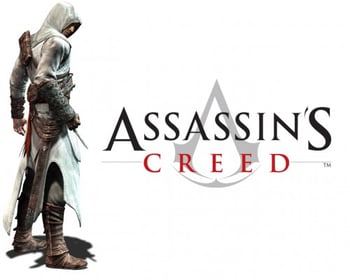
Genre
Action
Platform
Xbox 360, PC , PS3
Story
Meet Altair, part of the Brotherhood of Assassins. You heard that right, assassins. He lives in the middle ages, during the height of the crusades. After he botches a mission against the eviillll Templars (who came more out of Dan Brown than from history), his mentor sends him out to kill nine people involved in the crusades. There is, of course, a twist, and you will see it coming a mile away. Maybe two miles.
Gameplay/Mechanics
Run, jump, stab. Altair gets around by running – a variation on parkour – and by horse. He gathers information by going to certain places, and overhearing conversations, or finding someone and beating them up, or tripping over a target to pickpocket, and then we’re off to the killing. And then – oh, and then, dear gamer – you spend the next five minutes having a conversation with your target as he lies dying in your arms, right before you have to run away from a horde of his angry minions who all want you dead.
Let’s save each other the time. The gameplay is repetitive. The above paragraph is what you get exactly nine times. Doesn’t that sound like fun?
The fight mechanics are ham-handed and clunky, and when you do things right, you are rewarded by and overly bloody execution suitable to hacking someone to death with a giant knife. Assuming you aren’t ganged up on by everyone within a two block radius. And you’re likely to be. Why? Because there is no way to subtly do anything in this game. I’m surprised the little pickpocketing missions don’t end with the player killing someone. And I’m shocked that there was a second game in the series, never mind a game a year for several years.
Music/Graphics
Still here? Okay, fine, I’ll keep going.
The graphics are not bad – if you ignore that all the cities look almost exactly the same and will turn you around so badly that you can’t figure out where you’re going. The music is forgettable. Seriously, I can’t tell you a single note.
Morals/Appropriateness
Morals? You know there has to be a problem with any game that opens with a disclaimer that “people of every religion worked on this game, honest. Don’t be offended.” That’s the first warning sign. To make them seem fair and balanced, Altair’s targets are people on both sides of the crusades. Outside of that, there is no moral here.
I would say that this game is only appropriate for a full blown adult, if I thought it would be suitable for anybody. The only thing preventing me from a full on and graphic description of this game is the site rating.
Community/Multiplayer
None
Addiction Danger
None. I’m surprised I finished the game. I thought the game might be redeemed at some point. But there is no redemption for this game, not even the superior (thus far) sequel.
Problems/Ending Comments
There is a subplot in the 20th century involving a Desmond Miles – a distant relation of Altair. Desmond is being plugged into a machine that taps into his “genetic memories,” which is what leads us to be playing Altair in the first place. It’s a frame tale that goes nowhere. At all. In fact, having started the second game, I can tell you that the first game can be skipped altogether, and you will miss nothing of the overall plot, since the end of the first game was held off so it could be the opening of the second.
A big facet of the game is that you have to believe that Miles is being held captive by an eviiiiillll corporation that’s run by the Templars, who have been fighting the assassins since King Richard ran the crusades.
As for the game designers’ ability to follow history – their history is so badly put together, when Desmond tells the mad scientist in charge that history didn’t happen this way, the mad scientist says “You believe something just because it’s written in a book? Anyone can write something in a book. Someone once said the world was made in seven days. It’s a best seller, I hear.”
That was the point I had to quit for that session.
ESRB Rating: M for Mature
Copyright 2013 John Konecsni
About the Author

Guest
We welcome guest contributors who graciously volunteer their writing for our readers. Please support our guest writers by visiting their sites, purchasing their work, and leaving comments to thank them for sharing their gifts here on CatholicMom.com. To inquire about serving as a guest contributor, contact editor@CatholicMom.com.



.png?width=1806&height=731&name=CatholicMom_hcfm_logo1_pos_871c_2728c%20(002).png)
Comments